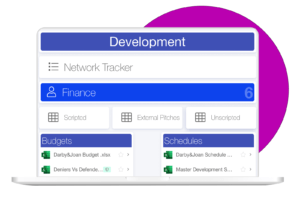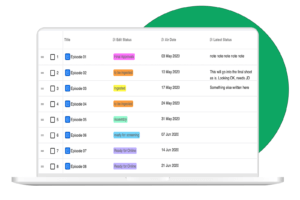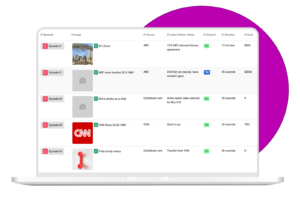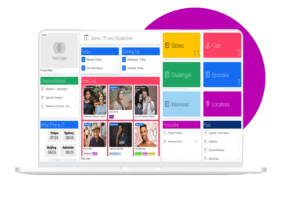If you work in television production, chances are you use a lot of different, unsynchronised tech to plan, track and communicate to deliver a show. Each show you work on likely has an array of files and folders, shared drives, and emails to share and store information.
For very small shows, this is probably all that’s needed. One or two documents, shared between a handful of people are easily managed, and can actually speed up work. When you are working on a large or fast-moving production, with lots of information and people coming and going, it becomes confusing and inefficient.
Imagine your whole team building, planning, and tracking all elements of the production in one place; protecting your IP in a secure, digital platform. No more running around, scribbled notes, convoluted email trails, or time wasted trying to get updates through outmoded distribution chains.
That’s exactly why Lumi was designed – to make production easier and enable teams to be their best together. Made by producers, for producers, it reduces the noise in production and brings cohesion to teams trying to deliver in a creative environment. From a financial perspective, it minimises total production hours, streamlines workflow, reduces duplication and other operational costs. Lumi is easy to learn, easy to use, and enables you to concentrate on the creative process while it does the heavy lifting on logistics.
7 ways Lumi makes production easier
1. Planning and development
- Manage pitches easily with a single, centralised point of collection for each brief.

- Get instant overviews of every pitch in flight – understand status, genre and who it’s already been pitched to. Access the detail behind each pitch with a simple click.
- Build dynamic IP banks – create a database of ideas, clients and resources once and draw on them again and again.
- Export quickly and easily from Lumi – create a bio, pitch document or report ready for your meeting.
- Move seamlessly from pitch through to sold and delivery.
2. Casting and audition management
- Casting and audition information is readily available through production and delivery.

- Visualise the cast. Drag-and-drop cards to find your ideal combination.
- Other teams can extract the information they need to do their jobs.
- Move seamlessly into production. Once your cast is locked, simply keep adding to their cast cards. The same card follows them through production.
Additionally, for reality and entertainment shows:
- Turn online applications into cast cards then pull them into a schedule and plan out your day.
- Monitor cast moving through rounds on audition day. See an overview and track the status of each applicant.
- See how many people have registered, how many are waiting, and see casting notes in real-time.
- Move seamlessly from casting to production and promotions.
- Once your cast is locked, simply keep adding to their cast cards – everyone works in the same place.
3. Field production
- Add field notes and hot sheets directly into Lumi or use live, time-coded shoot logs.

- Connect nightshifts and dayshifts in 24 hour turnaround.
- Notes are immediately “in place” and available for use in real-time.
- Create faster feedback loops and solve problems on the fly – know where the gaps are and save teams going back into the field.
- Save overshooting – know what you have and be confident to call time on a shoot.
- Clear communication between field and post-production regardless of location.
4. Post Production
- Real-time delivery of content into post-production.
- Get an instant overview of lots of moving parts via the dashboard.

- Plan in 3D – story, episode, and series rundowns. Move challenges, scenes, and story threads around on a visual board. See overviews and click through for detail.
- Visualise story arcs over time and pull the information on episode or story cards into a List for a powerful and instant overview of your work.
- Automate workflows – story types, characters, etc are categorised and sorted into relevant streams automatically.
- Create customised shortcuts, log the best moments, interviews, and scenes in timecode logs. Export the logs and marker direct to your edit to save time.
- Advanced search helps you find what you need instantly – a log, phrase, word, person’s interview etc.
- Track highlights instantly then export the logs and marker direct to your edit to save time.
5. Archive management
- Replace complicated archive spreadsheets with live Lumi Lists or Trackers.

- Use custom fields to be across an overview of archive material, cast, stories, and episodes with one click.
- With everyone working in the one place you’ll always be across the latest costings, status, and clearance.
6. Sponsor management
- With all departments working from the same place, it’s easy to ensure any client promises are kept.
- Track client briefs and sponsor mentions across programs.
- Ensure the integration and content teams are working together seamlessly.
7. Executive overviews
- Run projects end-to-end. Everything lives in Lumi.

- Improve team efficiency, reduce file sharing and long email trails.
- Template cards and documents for uniformity.
- Pull information seamlessly through your workflows without duplicating effort.
- Work at a macro or micro level. Get the level of detail you need, when you need it.
Lumi is making production easier by bringing production, editorial and post together, in one digital workplace. When Lumi is on board, work is easier, faster and cheaper. There is more creativity, more collaboration and more visibility.
Discover how Lumi can enable a great creative outcome for your show while making production easier.



